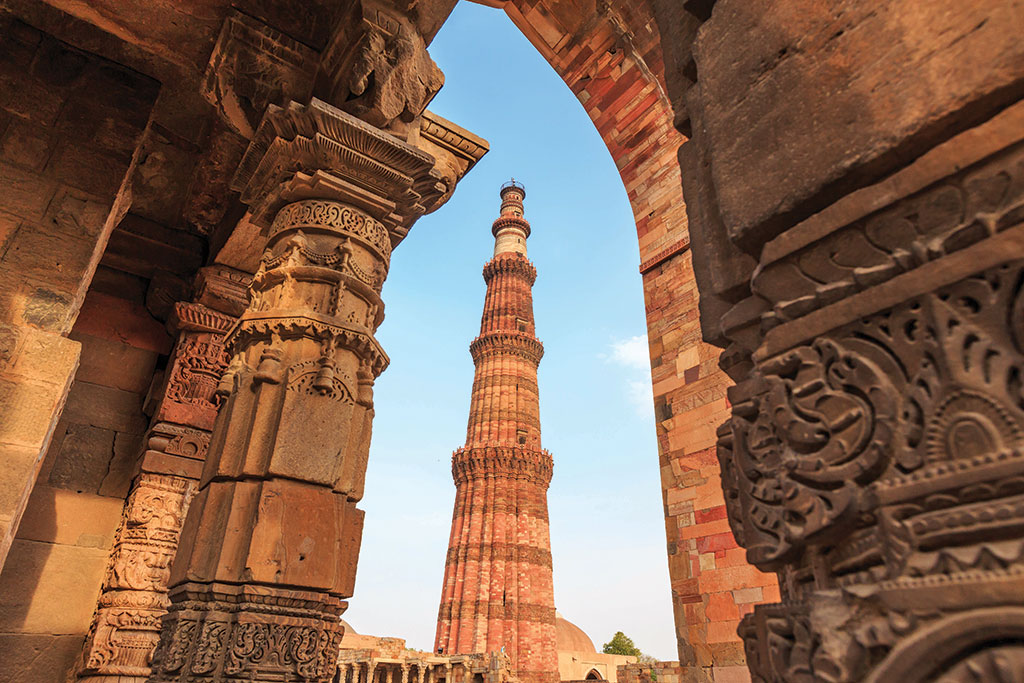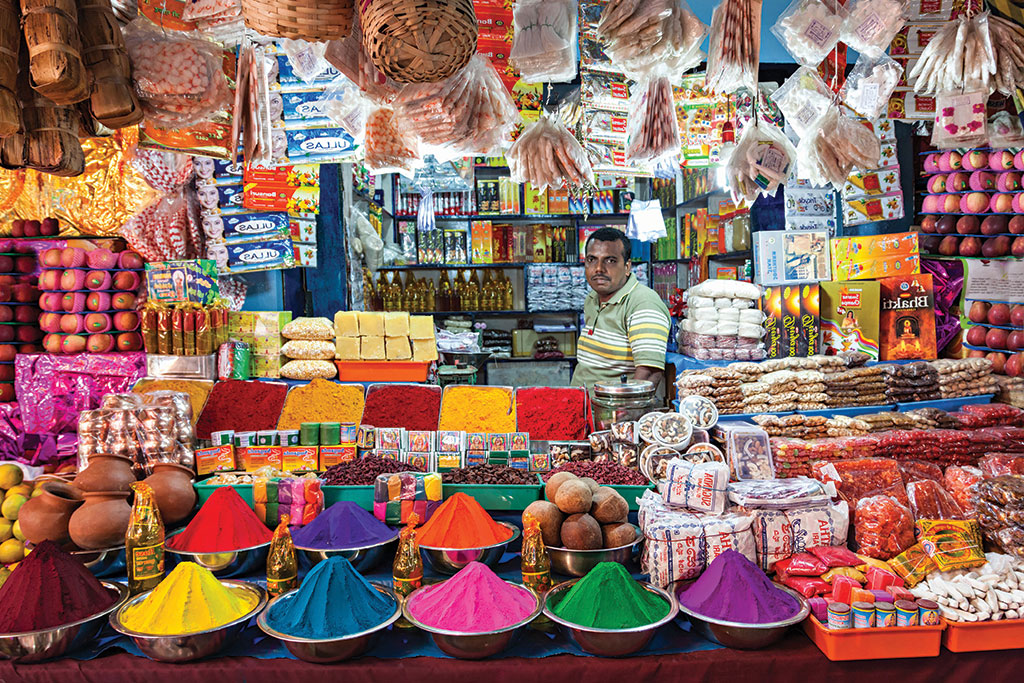Last August, in the bleary-eyed numbness induced by over 24 hours of flying—first from San Francisco to Singapore, then onward to Delhi—I was surprised when the driver taking me from the airport to my hotel slowed to a crawl.
I’d often heard that it was fairly common to see cows wandering on the roads in India, but I’d always envisioned this taking place on a rural country lane, not a densely trafficked four-lane highway.
But there I was, in a half-sleeping haze as dozens of cars, trucks, taxi cabs, and motorized rickshaws honked, drivers negotiated with hand signals, and everyone slowly steered their way around a cluster of five saggy- bellied old bessies.
In Hinduism, India’s most common religion, cows are revered. Their milk and its byproducts are cherished culinary staples, and eating beef is banned in most of the country’s 29 states. Often, when a household cow has passed her milking years, owners can no longer afford to feed her, and she is set loose in the streets, eating offerings from devout strangers wherever she roams.

Sacred Cows in Delhi
These particular cows were not crossing the road like the chickens in an American riddle, but reclining right in the middle of it, blithely sunning themselves as urban society bent to their will.
The whole scene felt like a fragment of a dream, the mundane colliding with the fantastic; timeless spirituality snarled in the traffic of contemporary priorities. Such sensations regularly struck me throughout the next week, as my partner John and I took a whirlwind journey through India’s Golden Triangle, the classic first-timer’s itinerary, connecting Delhi, Rajasthan, and Agra.
As much as we might have liked to understand this small swath of India in our short time there, we quickly realized that the best we could do was experience it. Endless snippets of historical, religious, and cultural fact whirled by us in the words of our guides, sometimes sticking, but more often fluttering away. It was feelings, evocations, and poetic perceptions that took more permanent hold.

John and I usually travel independently, cobbling together our accommodations and transport, and leaving room in our schedules for no small degree of improvisation. For a first visit to a country as complex and potentially overwhelming as India, especially since we planned to cover a lot of ground in a small amount of time, an organized tour proved the right choice.
We would be tagging along with a handful of gay travel agents from the US on a showcase itinerary impeccably curated by Luxe India (www.luxeindia.com), a renowned Delhi-based company that has recently committed to attracting more LGBT travelers. Creating customized packages for groups as small as a couple and as large as several dozen, Luxe India organizes complete tours at a range of price points.
Having successfully avoided steak tartare à la car, my driver arrived at the gates of the Oberoi Gurgaon (www.oberoihotels.com), a sleek arrangement of glassy rectangular blocks surrounding a turquoise reflecting pool with a Gucci boutique shimmering on its far shore. To a visitor who’s soaked up images of ancient India for months, this five-star hotel delivers an unexpected jolt of future shock.
It’s a reminder that beyond the historical sites that will dominate our visit, India is a major engine of the modern global economy. Gurgaon, also known as Gurugram, one of several satellite cities in the Delhi-centered megalopolis known as the National Capitol Region, is a business and financial hub and home to offices of over half of the Fortune 500 companies. High-rise residences and office buildings buzz surround shopping malls and public plazas, all connected by a whisper-quiet monorail that loops around Gurgaon’s core and connects out to the wide-sprawling Delhi metro system.
Business schedules had led John and I to fly in separately, but after a happy reunion in our room’s deliciously deep soaking tub and a few hours’ nap, we were ready to venture out together, taking advantage of a half day before our group itinerary began.
Uber service is readily available and remarkably affordable in Delhi (If you’re traveling solo, you can even choose to share a motorcycle seat). We opted for a car, and for less than five dollars took a ten-mile thrill ride (road construction is ubiquitous and lanes are interpreted as suggestions more than rules) to the most visited monument in all of India.
The Qutub Minar, is a graceful five-story sandstone and marble minaret constructed beginning in 1192 to honor the first Muslim kingdom of India. An elegant blend of Indian and Afghan styles, the tower is elaborately carved with calligraphic verses from the Qur’an.
Surrounded by stunning brick archways, tombs, small mosques, and columned arcades, the tower is the focal point of a lush green park, where families and couples gather to picnic and pass the time on sunny afternoons, and it’s the site’s popularity with locals that boosts the numbers of visitors to nearly four million a year. It is Delhi’s equivalent to the Luxembourg Gardens in Paris and a refreshing first dip into Indian antiquity.

Qutub Minar by Avigator Thailand
Afterward, we decided to make like locals and take the metro back toward our hotel and were surprised to discover that, in order to limit unwanted groping in rush hour crowds, Delhi trains include “women only” cars. Similarly, many taxis throughout the city are emblazoned with stickers reading “This cab respects women.” In India’s traditionally male- dominated culture, educated working women are becoming more commonplace, and the government is making an effort to make them feel safe in their independence.
Our metro ride also exposed us to the fact that Delhi’s transportation infrastructure doesn’t always take you exactly where you need to go; the closest stop to our hotel required a perilous, Frogger-like crossing of eight lanes of highway with not a single traffic signal in sight.
We were ready for the ease of an escorted group.
The next morning, we met our fellow travelers in an Oberoi lobby abuzz with activity. The hotel was hosting a conference of African diplomats, whose polyglot conversation mixed with English, Hindi, and, no doubt, some of India’s 22 other official languages, filling the room with a well-heeled, worldly air, and a reminder that white Westerners are not the only holders of privilege in today’s global society.
An hour-long crosstown ride by private motorcoach took us to the well-preserved pre-colonial enclave of Old Delhi for a visit to Jama Masjid, one of India’s largest Muslim mosques, followed by an early highlight of the entire week. Our guide, Jasvir Saurana, aka Jassi, an elegant young man with a degree in English literature—hailed bicycle rickshaws to ferry us in pairs through the old town marketplace, Chandni Chowk.
While we begrudgingly heeded Jassi’s warnings to not to partake of the tempting street food on offer, the marketplace provided a feast for our eyes, its narrow lanes an endlessly unfurling labyrinth of color and motion. Sari-draped women, arms bangled from wrist to elbow, sat on wooden crates and gestured toward sheets of burlap, thickly carpeted with jasmine, plumeria, marigolds and roses. Once purchased, their petals would become the fragile, fragrant tiles delicately arranged to form circular mosaics (known as rangoli) that float atop bowls of water, a ubiquitous element of Indian decor.

Shop in Delhi
Stick-slim mustachioed men nonchalantly carried 50-pound sacks of rice on their heads. Smiling teenage boys chipped huge blocks of ice, squeezed pyramids of lemons, and filled glass after glass with fresh lemonade, served with pastel pink plastic straws.
Other young men lorded over blankets spread with kaleidoscopic arrays of athletic shoes, their knock-off Reeboks and Nikes as glossy and tempting as the bright green papayas and glitter-sprinkled mangoes piled a few feet away (There are dozens of fruit vendors within a few crowded blocks, so this one bets a little bling will help him stand out).
At the nut-wallah’s shop, its heaps of pistachios and almonds, coconuts and dried datesr eflected the complexions of India—a dozen shades of warmth, impossible to summarize in a single, reductive “brown”.
We continued with a tour of the stark British propriety of Luyten’s Delhi (www.lutyensbunglo.co.in), a marked contrast to the happy chaos of Chandni Chowk. Driving through this central administrative area of the city, nicknamed for its master planner, architect Edwin Luytens, the manicured lawns, reflecting pools, and Christian cathedrals evoke a cool, colonial indifference to native Indian culture. Yet today, India’s government ministries, parliament, and the president and prime minister’s homes are located in these severely tasteful relics of a time gone by.


